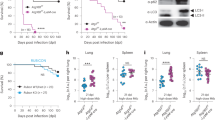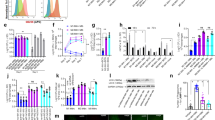Abstract
Suppression of major histocompatibility complex (MHC) class II antigen presentation is believed to be among the major mechanisms used by Mycobacterium tuberculosis to escape protective host immune responses. Through a genome-wide screen for the genetic loci of M. tuberculosis that inhibit MHC class II-restricted antigen presentation by mycobacteria-infected dendritic cells, we identified the PE_PGRS47 protein as one of the responsible factors. Targeted disruption of the PE_PGRS47 (Rv2741) gene led to attenuated growth of M. tuberculosis in vitro and in vivo, and a PE_PGRS47 mutant showed enhanced MHC class II-restricted antigen presentation during in vivo infection of mice. Analysis of the effects of deletion or over-expression of PE_PGRS47 implicated this protein in the inhibition of autophagy in infected host phagocytes. Our findings identify PE_PGRS47 as a functionally relevant, non-redundant bacterial factor in the modulation of innate and adaptive immunity by M. tuberculosis, suggesting strategies for improving antigen presentation and the generation of protective immunity during vaccination or infection.
This is a preview of subscription content, access via your institution
Access options
Subscribe to this journal
Receive 12 digital issues and online access to articles
$119.00 per year
only $9.92 per issue
Buy this article
- Purchase on Springer Link
- Instant access to full article PDF
Prices may be subject to local taxes which are calculated during checkout






Similar content being viewed by others
References
Wolf, A. J. et al. Mycobacterium tuberculosis infects dendritic cells with high frequency and impairs their function in vivo. J. Immunol. 179, 2509–2519 (2007).
Mogues, T., Goodrich, M. E., Ryan, L., LaCourse, R. & North, R. J. The relative importance of T cell subsets in immunity and immunopathology of airborne Mycobacterium tuberculosis infection in mice. J. Exp. Med. 193, 271–280 (2001).
Repique, C. J. et al. Susceptibility of mice deficient in the MHC class II transactivator to infection with Mycobacterium tuberculosis. Scand. J. Immunol. 58, 15–22 (2003).
Scanga, C. A. et al. Depletion of CD4+ T cells causes reactivation of murine persistent tuberculosis despite continued expression of interferon gamma and nitric oxide synthase 2. J. Exp. Med. 192, 347–358 (2000).
Baena, A. & Porcelli, S. A. Evasion and subversion of antigen presentation by Mycobacterium tuberculosis. Tissue Antigens 74, 189–204 (2009).
Harding, C. V. & Boom, W. H. Regulation of antigen presentation by Mycobacterium tuberculosis: a role for Toll-like receptors. Nature Rev. Microbiol. 8, 296–307 (2010).
Pai, R. K., Convery, M., Hamilton, T. A., Boom, W. H. & Harding, C. V. Inhibition of IFN-γ-induced class II transactivator expression by a 19-kDa lipoprotein from Mycobacterium tuberculosis: a potential mechanism for immune evasion. J. Immunol. 171, 175–184 (2003).
Pennini, M. E. et al. CCAAT/enhancer-binding protein β and δ binding to CIITA promoters is associated with the inhibition of CIITA expression in response to Mycobacterium tuberculosis 19-kDa lipoprotein. J. Immunol. 179, 6910–6918 (2007).
Dengjel, J. et al. Autophagy promotes MHC class II presentation of peptides from intracellular source proteins. Proc. Natl Acad. Sci. USA 102, 7922–7927 (2005).
Paludan, C. et al. Endogenous MHC class II processing of a viral nuclear antigen after autophagy. Science 307, 593–596 (2005).
Schmid, D., Pypaert, M. & Munz, C. Antigen-loading compartments for major histocompatibility complex class II molecules continuously receive input from autophagosomes. Immunity 26, 79–92 (2007).
Zhou, D. et al. Lamp-2a facilitates MHC class II presentation of cytoplasmic antigens. Immunity 22, 571–581 (2005).
Singh, S. B., Davis, A. S., Taylor, G. A. & Deretic, V. Human IRGM induces autophagy to eliminate intracellular mycobacteria. Science 313, 1438–1441 (2006).
Gutierrez, M. G. et al. Autophagy is a defense mechanism inhibiting BCG and Mycobacterium tuberculosis survival in infected macrophages. Cell 119, 753–766 (2004).
Shin, D. M. et al. Mycobacterium tuberculosis Eis regulates autophagy, inflammation, and cell death through redox-dependent signaling. PLoS Pathogens 6, e1001230 (2010).
Romagnoli, A. et al. ESX-1 dependent impairment of autophagic flux by Mycobacterium tuberculosis in human dendritic cells. Autophagy 8, 1357–1370 (2012).
Espert, L., Beaumelle, B. & Vergne, I. Autophagy in Mycobacterium tuberculosis and HIV infections. Front. Cell. Infect. Microbiol. 5, 49 (2015).
Rudensky, A., Preston-Hurlburt, P., Hong, S. C., Barlow, A. & Janeway, C. A. Jr. Sequence analysis of peptides bound to MHC class II molecules. Nature 353, 622–627 (1991).
Deretic, V., Saitoh, T. & Akira, S. Autophagy in infection, inflammation and immunity. Nature Rev. Immunol. 13, 722–737 (2013).
Munz, C. Enhancing immunity through autophagy. Annu. Rev. Immunol. 27, 423–449 (2009).
Mizushima, N., Yoshimori, T. & Levine, B. Methods in mammalian autophagy research. Cell 140, 313–326 (2010).
Tian, C. & Jian-Ping, X. Roles of PE_PGRS family in Mycobacterium tuberculosis pathogenesis and novel measures against tuberculosis. Microb. Pathog. 49, 311–314 (2010).
Brennan, M. J. & Delogu, G. The PE multigene family: a ‘molecular mantra’ for mycobacteria. Trends Microbiol. 10, 246–249 (2002).
Bardarov, S. et al. Specialized transduction: an efficient method for generating marked and unmarked targeted gene disruptions in Mycobacterium tuberculosis, M. bovis BCG and M. smegmatis. Microbiology 148, 3007–3017 (2002).
Rusten, T. E. & Stenmark, H. p62, an autophagy hero or culprit? Nature Cell Biol. 12, 207–209 (2010).
Bold, T. D., Banaei, N., Wolf, A. J. & Ernst, J. D. Suboptimal activation of antigen-specific CD4+ effector cells enables persistence of M. tuberculosis in vivo. PLoS Pathogens 7, e1002063 (2011).
Reiley, W. W. et al. ESAT-6-specific CD4T cell responses to aerosol Mycobacterium tuberculosis infection are initiated in the mediastinal lymph nodes. Proc. Natl Acad. Sci. USA. 105, 10961–10966 (2008).
Kruh, N. A., Troudt, J., Izzo, A., Prenni, J. & Dobos, K. M. Portrait of a pathogen: the Mycobacterium tuberculosis proteome in vivo. PLoS ONE 5, e13938 (2010).
Simeone, R., Bottai, D., Frigui, W., Majlessi, L. & Brosch, R. ESX/type VII secretion systems of mycobacteria: insights into evolution, pathogenicity and protection. Tuberculosis (Edinb.) 95(Suppl 1), S150–S154 (2015).
Srivastava, V., Jain, A., Srivastava, B. S. & Srivastava, R. Selection of genes of Mycobacterium tuberculosis upregulated during residence in lungs of infected mice. Tuberculosis (Edinb.) 88, 171–177 (2008).
Copin, R. et al. Sequence diversity in the pe_pgrs genes of Mycobacterium tuberculosis is independent of human T cell recognition. mBio 5, e00960–e00913 (2014).
Lee, H. K. et al. In vivo requirement for Atg5 in antigen presentation by dendritic cells. Immunity 32, 227–239 (2010).
Deretic, V. Autophagy, an immunologic magic bullet: Mycobacterium tuberculosis phagosome maturation block and how to bypass it. Future Microbiol. 3, 517–524 (2008).
Koul, A., Herget, T., Klebl, B. & Ullrich, A. Interplay between mycobacteria and host signalling pathways. Nature Rev. Microbiol. 2, 189–202 (2004).
Watson, R. O., Manzanillo, P. S. & Cox, J. S. Extracellular M. tuberculosis DNA targets bacteria for autophagy by activating the host DNA-sensing pathway. Cell 150, 803–815 (2012).
Ouimet, M. et al. Mycobacterium tuberculosis induces the miR-33 locus to reprogram autophagy and host lipid metabolism. Nature Immunol. 17, 677–686 (2016).
Kimmey, J. M. et al. Unique role for ATG5 in neutrophil-mediated immunopathology during M. tuberculosis infection. Nature 528, 565–569 (2015).
Cadieux, N. et al. Induction of cell death after localization to the host cell mitochondria by the Mycobacterium tuberculosis PE_PGRS33 protein. Microbiology 157, 793–804 (2011).
Braunstein, M., Bardarov, S. S. & Jacobs, W. R. Jr. Genetic methods for deciphering virulence determinants of Mycobacterium tuberculosis. Methods Enzymol. 358, 67–99 (2002).
Stover, C. K. et al. New use of BCG for recombinant vaccines. Nature 351, 456–460 (1991).
Hinchey, J. et al. Enhanced priming of adaptive immunity by a proapoptotic mutant of Mycobacterium tuberculosis. J. Clin. Invest. 117, 2279–2288 (2007).
Lutz, M. B. et al. An advanced culture method for generating large quantities of highly pure dendritic cells from mouse bone marrow. J. Immunol. Methods 223, 77–92 (1999).
Houben, E. N., Nguyen, L. & Pieters, J. Interaction of pathogenic mycobacteria with the host immune system. Curr. Opin. Microbiol. 9, 76–85 (2006).
Mizushima, N., Yamamoto, A., Matsui, M., Yoshimori, T. & Ohsumi, Y. In vivo analysis of autophagy in response to nutrient starvation using transgenic mice expressing a fluorescent autophagosome marker. Mol. Biol. Cell 15, 1101–1111 (2004).
Forestier, C. et al. Improved outcomes in NOD mice treated with a novel Th2 cytokine-biasing NKT cell activator. J. Immunol. 178, 1415–1425 (2007).
Yuk, J. M. et al. Vitamin D3 induces autophagy in human monocytes/macrophages via cathelicidin. Cell Host Microbe 6, 231–243 (2009).
Averill, L. E. et al. Screening of a cosmid library of Mycobacterium bovis BCG in Mycobacterium smegmatis for novel T-cell stimulatory antigens. Res. Microbiol. 144, 349–362 (1993).
Barlow, A. K., He, X. & Janeway, C. Jr. Exogenously provided peptides of a self-antigen can be processed into forms that are recognized by self-T cells. J. Exp. Med. 187, 1403–1415 (1998).
Clarke, L. & Carbon, J. A colony bank containing synthetic Col El hybrid plasmids representative of the entire E. coli genome. Cell 9, 91–99 (1976).
Pavelka, M. S. Jr & Jacobs, W. R. Jr. Comparison of the construction of unmarked deletion mutations in Mycobacterium smegmatis, Mycobacterium bovis bacillus Calmette-Guerin, and Mycobacterium tuberculosis H37Rv by allelic exchange. J. Bacteriol. 181, 4780–4789 (1999).
Prados-Rosales, R. et al. Mycobacteria release active membrane vesicles that modulate immune responses in a TLR2-dependent manner in mice. J. Clin. Invest. 121, 1471–1483 (2011).
Acknowledgements
The authors thank the staff of the Flow Cytometry Core Facility of the Albert Einstein College of Medicine (supported by the Einstein Cancer Center grant NIH/NCI CA13330). The authors acknowledge the NIH Tetramer Core Facility (contract no. HHSN272201300006C) for provision of the I-Ab/TB9.8 tetramers. This work was supported by NIH grants AI093649 to S.A.P. and AI063537 to S.A.P., W.R.J. and J.C. The authors thank N. Mizushima, Tokyo Medical and Dental University, for providing the GFP-LC3 lentivirus construct and A.Y. Rudensky for providing the Y-Ae hybridoma. The authors also thank P. Jain and P. A. Gonzalez for their suggestions on the construction of the ΔPE_PGRS47 mutant strain and R. Sellers for assistance in analysis of histopathology. A.B. acknowledges support from ‘Estrategia de Sostenibilidad Universidad de Antioquia’. The authors thank R. Prados-Rosales for assistance with EM studies and E. Bejarano for advice on autophagy analysis.
Author information
Authors and Affiliations
Contributions
N.K.S., A.B. and T.W.N. designed and carried out experiments. S.A.P. supervised the design and execution of all experiments. M.M.V., S.C.K., S.K.-V., L.J.C. and J.X. assisted in the execution of selected experiments. J.C., M.H.L. and W.R.J. provided input on the design of experiments and data interpretation. All authors contributed to writing and editing the manuscript.
Corresponding author
Ethics declarations
Competing interests
The authors declare no competing financial interests.
Supplementary information
Supplementary information
Supplemenary Figures 1-10, Supplementary References (PDF 1482 kb)
Rights and permissions
About this article
Cite this article
Saini, N., Baena, A., Ng, T. et al. Suppression of autophagy and antigen presentation by Mycobacterium tuberculosis PE_PGRS47. Nat Microbiol 1, 16133 (2016). https://doi.org/10.1038/nmicrobiol.2016.133
Received:
Accepted:
Published:
DOI: https://doi.org/10.1038/nmicrobiol.2016.133
This article is cited by
-
Brain glucose induces tolerance of Cryptococcus neoformans to amphotericin B during meningitis
Nature Microbiology (2024)
-
Functional Analysis of Genes in Mycobacterium tuberculosis Action Against Autophagosome–Lysosome Fusion
Indian Journal of Microbiology (2024)
-
TRAF6 triggers Mycobacterium-infected host autophagy through Rab7 ubiquitination
Cell Death Discovery (2023)
-
Reversing BCG-mediated autophagy inhibition and mycobacterial survival to improve vaccine efficacy
BMC Immunology (2022)
-
A glycine-rich PE_PGRS protein governs mycobacterial actin-based motility
Nature Communications (2022)



